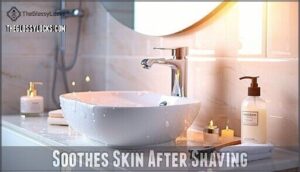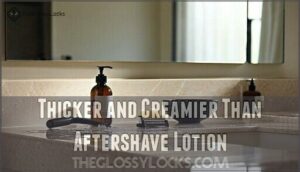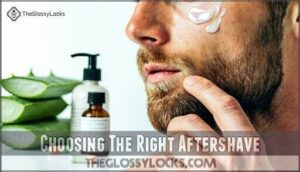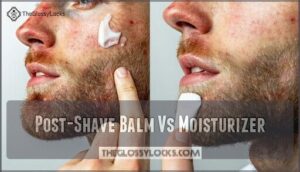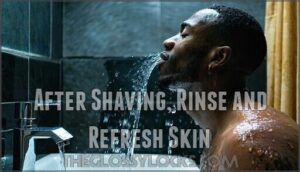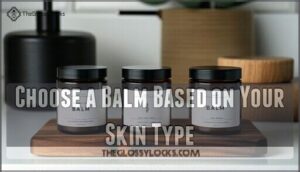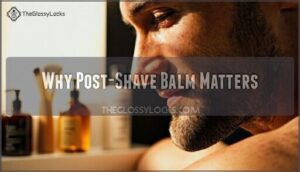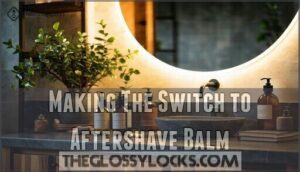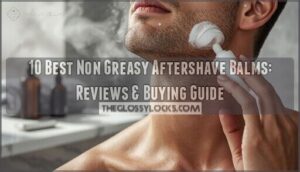This site is supported by our readers. We may earn a commission, at no cost to you, if you purchase through links.
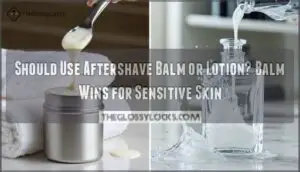
If you’ve got sensitive or dry skin, aftershave balm is your best friend – it’s alcohol-free, moisturizing, and won’t leave you looking like a tomato.
Those with oily or acne-prone skin can handle aftershave lotion’s astringent properties better.
The key difference is that balms soothe and hydrate while lotions disinfect but can dry you out.
Think of balm as a gentle hug for your face, while lotion’s more like a firm handshake that might sting a bit.
Smart ingredient choices make all the difference in your post-shave game, with the right selection being crucial for a comfortable and healthy shave, and complete concepts like these are essential to understand.
Table Of Contents
- Key Takeaways
- Aftershave Lotion Vs Balm
- Aftershave Balm Benefits
- What to Avoid in Aftershave
- Choosing The Right Aftershave
- Post-Shave Balm Vs Moisturizer
- How to Use Post-Shave Balm
- Why Post-Shave Balm Matters
- Making The Switch to Aftershave Balm
- Frequently Asked Questions (FAQs)
- Can I use after shave balm as lotion?
- What is the best thing to put after shave?
- Is post-shave balm and aftershave the same thing?
- Is it better to use oil or lotion after shaving?
- Can you use aftershave balm as lotion?
- Should I use aftershave balm or aftershave splash?
- Should I put lotion on after shaving?
- What is aftershave balm used for?
- Will aftershave balm irritate my skin?
- How do I know if I have sensitive skin?
- Conclusion
Key Takeaways
- Choose balm for sensitive or dry skin – You’ll get alcohol-free moisturizing that won’t sting or strip your natural oils, preventing redness and irritation.
- Pick lotion for oily or acne-prone skin – You can handle the astringent properties better, though it may dry you out and cause stinging.
- Avoid harsh ingredients like alcohol and synthetic fragrances – You’re better off with natural alternatives like aloe vera, witch hazel, and vitamin E that actually heal your skin.
- Apply balm properly after rinsing with warm then cold water – You’ll get maximum benefits by using a dime-sized amount and massaging it in circular motions for even coverage.
Aftershave Lotion Vs Balm
You’re likely choosing between aftershave lotion and balm, wondering which option best suits your post-shave routine.
Traditional aftershave lotions pack a scented, alcohol-based punch that disinfects cuts while delivering that classic bracing sensation you might remember from barbershops.
Scented and Often Alcohol-Based
Most aftershave lotions pack a one-two punch with high alcohol content and strong fragrances that can backfire on your skin.
While that masculine scent might seem appealing, the alcohol-based formula often creates more problems than it solves.
| Alcohol Content Effects | Impact on Skin Types |
|---|---|
| Strips natural oils | Worse for dry/sensitive skin |
| Creates stinging sensation | Tolerable for oily skin |
| Temporarily tightens pores | Short-term cosmetic effect |
| Provides antiseptic action | Prevents minor infections |
| Enhances fragrance delivery | Appeals to scent preferences |
The fragrance effects might satisfy your scent preferences, but they often mask underlying irritation rather than addressing it.
Calms Shaving Irritation and Disinfects
Why does your face feel like it’s been through a battle after shaving? Post-shave care with disinfecting properties can provide essential irritation relief and skin soothing comfort.
| Benefit | Aftershave Lotion | Aftershave Balm |
|---|---|---|
| Disinfects cuts | Strong alcohol content | Mild antiseptic ingredients |
| Irritation relief | Temporary cooling effect | Long-lasting soothing |
| Skin comfort | Bracing sensation | Gentle moisturizing |
| Razor burn relief | May increase dryness | Reduces inflammation |
| Shaving comfort | Stinging on sensitive areas | Pain-free application |
Aftershave balm benefits include superior skin soothing products that deliver lasting post shave care without harsh stinging sensations. Many balms include skin soothing aloe to reduce redness, providing essential irritation relief and long-lasting soothing comfort, which is crucial for pain-free application and overall skin comfort.
Can Worsen Irritation, Dry Skin, and Cause Flaking
Despite its benefits, aftershave lotion’s high alcohol content can backfire on your skin.
The very ingredient that disinfects cuts also strips away natural oils, creating a cascade of problems that leave you worse off than before shaving.
| Issue | Cause | Result |
|---|---|---|
| Skin Irritation | Alcohol Sensitivity | Burning, stinging sensation |
| Dry Skin | Skin Barrier Damage | Tight, uncomfortable feeling |
| Flaking | Exfoliation Imbalance | Visible peeling, ashy appearance |
| Redness | Fragrance Allergens |
Inflamed, blotchy complexion.
Those with sensitive skin face the worst effects.
Product Ingredients like high alcohol concentrations and synthetic fragrances compound Shaving Irritation rather than soothe it.
This explains why aftershave balm often proves gentler—it skips harsh alcohols while delivering moisture your skin actually needs.
Aftershave Balm Benefits
If you’ve got sensitive skin that rebels against traditional aftershave, balm might be your skin’s new best friend.
Research shows that 70% of people with dry or sensitive skin benefit more from balms than alcohol-based lotions, which can leave your face feeling like you’ve splashed it with fire, and this is especially important for those with sensitive skin.
Soothes Skin After Shaving
Your aftershave balm works like a gentle rescue team for post-shave trauma.
While shaving strips away natural oils and irritates follicles, quality skin soothing products containing skin soothing ingredients deliver immediate skin relief.
The balm’s hydrating formula calms inflammation, reduces redness, and repairs micro-damage from razor contact.
Sensitive skin especially benefits from this post shave care, as aftershave benefits include restoring moisture balance and preventing uncomfortable tightness that often follows aggressive shave care.
Using a balm with natural ingredients can provide post shave benefits that help soothe and protect the skin.
Generally Does Not Contain Alcohol and Moisturizes
Your skin gets a break when you choose alcohol-free aftershave balm.
Your skin finally gets the gentle treatment it deserves with alcohol-free aftershave balm.
Most balms skip the harsh alcohol that stings and dries out your face after shaving.
Here’s what alcohol-free balms deliver for skin hydration:
- Gentle moisturization: Hydrates without irritation or burning sensations
- Sensitive skin relief: Perfect for those prone to redness and inflammation
- Enhanced skin barrier: Strengthens your skin’s natural protective function
- Long-lasting comfort: Prevents the tight, dry feeling alcohol-based products cause
These moisturizing effects make balms ideal for dry skin types seeking proper aftershave care.
Thicker and Creamier Than Aftershave Lotion
Beyond alcohol-free moisturizing properties, aftershave balm delivers a creamy consistency that transforms your post-shave routine.
This rich formula provides superior hydration benefits compared to thin aftershave lotion.
The moisturizing properties create a protective barrier, making it perfect for sensitive skin that needs gentle care.
Your skin texture improves with each application, leaving you feeling refreshed and comfortable.
What to Avoid in Aftershave
When choosing aftershave products, you’ll want to steer clear of harsh chemicals that can irritate your skin rather than soothe it.
Many commercial aftershaves contain ingredients like alcohol, synthetic fragrances, and preservatives that can cause redness, dryness, and long-term skin damage.
Toxic Ingredients to Watch Out For
Breaking down toxic ingredients helps you dodge potential skin disasters lurking in aftershave products.
Alcohol-based compounds like isopropyl and ethyl alcohol strip your skin’s natural oils, triggering dryness and irritation that can worsen existing conditions.
These harsh chemicals disrupt your skin’s protective barrier, leaving you vulnerable to inflammation and flaking.
Phthalates represent another category of harmful additives that act as endocrine disruptors, potentially affecting hormone levels over time.
Look for DEHP and DNOP on labels—these toxic substances have no business touching your freshly shaved face.
Fragrance toxins containing synthetic compounds can trigger allergic reactions and headaches.
These skin irritants often hide behind vague "fragrance" labels, making them difficult to identify but easy to avoid by choosing fragrance-free alternatives.
Understanding the risks of harmful chemicals in aftershave, such as those found in aftershave products, is essential for making informed decisions about your skincare routine.
Phthalates and Fragrance
When you’re scanning aftershave ingredients, watch out for two major red flags that could spell trouble for your skin and health.
Phthalates
These sneaky chemicals do more than just extend scent longevity in your aftershave lotion.
Diethyl phthalate (DEP) appears in over 70% of fragranced products, binding oils to your skin while potentially disrupting your hormones.
Studies link phthalate effects to reduced sperm quality and endocrine issues.
You’ll find them hiding behind vague labels, so look for DEP, DEHP, and DBP specifically.
Fragrance
That innocent "fragrance" or "parfum" listing?
It’s basically a black box of potentially toxic ingredients.
Fragrance chemistry allows manufacturers to skip disclosure, masking phthalates and other skin reactions triggers.
These scented products can irritate sensitive skin while delivering a cocktail of undisclosed compounds.
Your face deserves better than mystery chemicals that could cause long-term harm.
Experts recommend avoiding products with hormone disrupting chemicals to minimize health risks.
Natural Alternatives to Harmful Ingredients
The good news? You can ditch those harsh chemicals for gentler, natural alternatives that work just as well.
Your skin will thank you for making the switch to these soothing ingredients:
- Organic oils like jojoba and coconut provide natural moisturizers without irritation
- Herbal remedies such as witch hazel offer antiseptic properties minus the sting
- Essential extracts from aloe vera deliver cooling relief for sensitive skin
- Botanical ingredients create alcohol-free formulas that truly nourish
Choosing The Right Aftershave
You’ll want to focus on ingredients that actually help your skin recover from shaving rather than just smell good.
Look for products with proven soothing compounds like vitamin E, aloe vera, and witch hazel that calm irritation without causing additional problems.
Ingredients to Embrace for Healthy Skin
Your skin deserves Natural Oils and Soothing Agents that actually work.
Choose aftershaves packed with Moisturizing Compounds like glycerin and aloe vera for deep hydration.
Look for natural ingredients such as witch hazel’s astringent power, chamomile’s anti-inflammatory magic, and allantoin’s healing touch.
These Skin Nutrients provide genuine skin nourishment and skin smoothing without harsh chemicals that strip your face raw.
Vitamin E, Aloe Vera, and White Tea Leaf Extract
Three powerhouse natural remedies deliver exceptional antioxidant benefits for post-shave care.
Vitamin E shields skin from environmental damage while locking in moisture. Aloe vera accelerates healing with its soothing properties and deep hydration. White tea leaf extract fights inflammation and supports skin regeneration.
These herbal extracts work together in quality aftershave balm formulations, offering superior comfort compared to traditional aftershave lotion.
The use of Vitamin E products can enhance the overall effectiveness of aftershave balms.
Witch Hazel and Allantoin for Soothing Effects
Beyond vitamins and botanicals, you’ll find two powerhouse soothing agents that transform your post-shave experience. Witch hazel acts as nature’s gentle antiseptic, delivering aftershave benefits without alcohol’s harsh sting. Meanwhile, allantoin works behind the scenes promoting skin repair and regeneration.
These natural ingredients create gentle formulas that calm irritation while supporting healing:
- Witch hazel provides antibacterial protection without drying your skin
- Allantoin stimulates healthy cell turnover for faster recovery
- Both ingredients reduce inflammation and redness immediately after shaving
- Together they create a cooling sensation that soothes razor burn
When choosing an aftershave balm, look for products featuring these soothing ingredients. They offer the perfect balance of protection and comfort, making them ideal for anyone seeking effective skin soothing without harsh chemicals. Your face deserves this gentle approach to post-shave care.
Post-Shave Balm Vs Moisturizer
You might wonder if your regular moisturizer can replace a dedicated post-shave balm after your morning routine.
While both products hydrate skin, post-shave balms are specifically formulated to address the unique irritation, micro-cuts, and inflammation that shaving creates.
Counteracts Irritation and Soothes Skin
After dragging a razor across your face, irritation becomes your skin’s unwelcome companion. Aftershave balm delivers targeted Skin Relief through specialized Soothing Agents that regular moisturizers can’t match.
Your razor creates tiny wounds that need healing, not harsh alcohol that makes them worse.
Post Shave Care requires precision – balms contain Irritation Control ingredients like allantoin and witch hazel. These combat razor burn more effectively than generic moisturizers.
| Factor | Post-Shave Balm | Regular Moisturizer |
|---|---|---|
| Healing Power | Contains antiseptic properties | Lacks therapeutic ingredients |
| Sensitivity | Formulated for Sensitive Skin | May contain irritating fragrances |
| Recovery Time | Accelerates skin repair | Provides basic hydration only |
Aftershave balm transforms your skin irritation into comfort, while soothing aftershave gel and specialized lotion for razor burn target post-shave trauma specifically.
Prevents Redness, Dryness, and Infections
Post-shave balm acts as your skin’s bodyguard against the three biggest shaving threats.
While soothing aftershave gel calms immediate irritation, balm provides longer-lasting Redness Prevention and Dry Skin Care.
Here’s how aftershave balm outperforms aftershave lotion:
| Issue | Aftershave Balm | Aftershave Lotion |
|---|---|---|
| Redness Prevention | Alcohol-free formula soothes inflammation | Alcohol content can worsen redness |
| Infection Control | Natural antiseptics protect cuts | Harsh alcohol may over-dry wounds |
| Post Shave Relief | Moisturizing agents prevent flaking | Can strip natural skin oils |
| Skin Irritation | Skin Soothing ingredients calm razor burn | May increase sensitivity over time |
Think of balm as Infection Control insurance—it protects minor nicks while delivering targeted Post Shave Relief without the sting.
Maintains a Smooth, Healthy Complexion
Regular moisturizers can’t match aftershave balm’s specialized formula for post-shave recovery. Your complexion stays balanced when you choose products designed for facial skin.
Aftershave balm delivers targeted skin hydration while promoting smooth texture and healthy glow through gentle, nourishing ingredients that support long-term complexion care. Understanding the differences in post shave products is essential for maintaining healthy skin.
| Feature | Aftershave Balm | Regular Moisturizer | Aftershave Lotion |
|---|---|---|---|
| Skin Hydration | Deep, targeted | General moisture | Limited hydration |
| Texture Result | Smooth, refined | Varies by formula | Can feel tight |
| Facial Balance | Specialized care | Basic maintenance | May disrupt pH |
| Healing Properties | Enhanced recovery | Minimal repair | Antiseptic only |
| Sensitivity | Gentle formula | May contain irritants | Often harsh |
How to Use Post-Shave Balm
Knowing how to properly apply post-shave balm can make the difference between irritated, dry skin and a smooth, comfortable complexion.
The right technique guarantees you get maximum benefits from your balm while avoiding common application mistakes that can reduce its effectiveness.
After Shaving, Rinse and Refresh Skin
After shaving, rinse your face with warm water to clear away shaving cream and loose hairs.
Follow with a cold water splash for skin refresh and pore tightening. This simple post shave ritual prepares your skin for aftershave care.
Here’s why proper rinsing matters:
- Removes irritating residue that could trigger razor burn
- Opens then closes pores for better skin conditioning
- Stimulates blood flow to promote healing
- Prepares skin to absorb aftershave balm effectively
Choose a Balm Based on Your Skin Type
Once you’ve refreshed your skin, matching your aftershave balm to your specific skin type maximizes its effectiveness.
Different skin conditions require targeted approaches for superior results. Understanding the various Aftershave Balm options is essential for making an informed decision.
- Sensitive Skin: Choose fragrance-free, alcohol-free balms with chamomile or aloe vera to prevent irritation and redness.
- Dry Skin: Select rich, moisturizing formulas containing shea butter or glycerin for deep hydration and barrier repair.
- Oily Skin: Pick lightweight, non-comedogenic balms that won’t clog pores or add unwanted shine.
Apply and Massage for Even Coverage
Once you’ve selected your aftershave balm, squeeze a dime-sized amount into your palm.
Gently massage the balm into freshly shaved areas using circular motions for ideal skin coverage.
This massage technique promotes even application and enhances skin relief.
The post shave ritual helps your skin absorb the balm’s moisturizing benefits without overwhelming your pores.
Why Post-Shave Balm Matters
Adding post-shave balm to your routine isn’t just about comfort—it’s an investment in your skin’s long-term health.
Research shows that consistent use can prevent cumulative damage from daily shaving and maintain healthier skin over time.
A Crucial Step in Your Skincare Routine
Your aftershave balm choice shapes your entire skincare routine and overall skin health.
Post-shave care isn’t just about immediate comfort—it’s about building habits that protect your skin long-term.
Consider these aftershave benefits for different skin types:
- Sensitive skin finds relief from alcohol-free formulations
- Dry skin absorbs moisture from nourishing ingredients
- Oily skin benefits from lightweight, non-comedogenic options
- All skin types deserve protection from daily shaving stress.
Smart shaving tips include matching your aftershave lotion uses to your specific needs.
Prevents Long-Term Skin Damage
Daily shaving creates micro-damage that accumulates over time, leading to premature aging and skin damage.
Post-shave balm provides essential damage control through protective ingredients that strengthen your skin barrier.
This irritation relief isn’t just comfort—it’s longterm skin health insurance.
Sensitive skin particularly benefits from balm’s skin protection, preventing chronic inflammation that accelerates aging.
Invests in Long-Term Skin Health
Beyond preventing immediate damage, choosing quality postshave care becomes your investment in tomorrow’s skin. Think of aftershave balm as your skin’s retirement fund—small daily contributions that pay massive dividends over time.
Your skin remembers every shave, every nick, every moment of irritation. Without proper skin moisturizing and skin repair, these micro-traumas accumulate like compound interest, leading to premature aging, scarring, and sensitivity. Quality aftershave balm breaks this cycle, promoting longevity tips through consistent natural remedies.
Here’s how smart postshave care builds longterm skin health:
- Prevents collagen breakdown from repeated inflammation and razor damage
- Maintains skin barrier integrity through consistent skin care practices
- Reduces hyperpigmentation from healing razor burns and ingrown hairs
- Preserves elasticity by keeping skin hydrated and supple daily
- Creates protective habits that compound into a healthy glow over decades
Unlike aftershave lotion’s temporary sting-and-forget approach, balm nurtures your skin’s foundation, ensuring each shave strengthens rather than weakens your complexion.
Making The Switch to Aftershave Balm
You’re ready to make the switch from harsh, alcohol-based aftershaves to gentle, nourishing balms that actually care for your skin.
Finding the right balm means considering your skin type, reading ingredient lists carefully, and trying different formulations until you discover what works best for your post-shave routine, which involves a process of trial and error to find the perfect balm.
Ditching Harmful Ingredients for Good
Making the switch to natural skincare means saying goodbye to harsh chemicals that damage your skin.
Alcohol-free aftershave balms packed with natural ingredients offer safe alternatives to traditional lotions.
These gentle products use soothing ingredients like aloe vera instead of synthetic fragrances.
Choose toxic free, eco friendly options that actually heal your skin rather than irritate it further.
Finding The Perfect Balm for Your Skin
Your search for the perfect aftershave balm starts with identifying your specific skin type and conditions.
Sensitive skin requires alcohol-free formulas with chamomile and aloe vera, while oily skin benefits from lightweight, non-comedogenic balm ingredients like witch hazel.
Read labels carefully—quality aftershave products contain glycerin, vitamin E, and natural oils that deliver genuine balm benefits for your unique shaving routine.
Understanding balm product options is essential in making an informed decision for your skin care needs.
Experimenting With Different Types of Balms
Three aftershave balm types deserve your attention: lightweight gel-based formulas for oily skin, rich cream balm ingredients like shea butter for dry complexions, and silicone-based options for quick absorption.
Test different balm types to discover which skin benefits and shaving relief work best.
Your post-shave care routine improves through experimentation.
Frequently Asked Questions (FAQs)
Can I use after shave balm as lotion?
You can use aftershave balm as facial lotion since it’s designed to moisturize and soothe skin. However, it’s thicker than regular lotions and may feel heavy on non-shaved areas.
What is the best thing to put after shave?
One size doesn’t fit all when choosing aftershave products.
You’ll want balm for dry or sensitive skin since it’s alcohol-free and deeply moisturizing.
Choose lotion if you’ve got oily skin and prefer that traditional tingling sensation.
Is post-shave balm and aftershave the same thing?
Post-shave balm and aftershave aren’t identical twins, but they’re close cousins. Aftershave traditionally means alcohol-based splash, while balm’s the moisturizing, alcohol-free option that soothes without the sting.
Is it better to use oil or lotion after shaving?
After shaving, lotion typically works better than oil.
Lotions provide balanced hydration without clogging pores, while oils can feel heavy and may trap bacteria.
Choose alcohol-free lotions for sensitive skin relief.
Can you use aftershave balm as lotion?
Aftershave balm can work as body lotion, but it’s formulated specifically for post-shave care. You’ll get better results using dedicated facial or body moisturizers for daily hydration needs.
Should I use aftershave balm or aftershave splash?
Choose aftershave balm if you’ve got sensitive or dry skin—it’ll moisturize without the sting. Go with splash if you want that classic bracing effect and have tougher skin.
Should I put lotion on after shaving?
You don’t need to investigate complex theories here – the answer’s straightforward.
Yes, you should use lotion after shaving, but choose wisely.
Balms work better for sensitive or dry skin, while lighter lotions suit oily skin types perfectly.
What is aftershave balm used for?
You’ll find aftershave balm moisturizes and soothes your skin after shaving, reducing irritation and razor burn while strengthening your skin’s protective barrier for comfort.
Will aftershave balm irritate my skin?
Like a gentle breeze after a storm, aftershave balm won’t irritate your skin.
It’s alcohol-free and packed with soothing ingredients like aloe vera, making it perfect for sensitive skin that needs tender care.
How do I know if I have sensitive skin?
Your skin shows its sensitivity through clear signals: frequent redness, stinging from basic products, or irritation after shaving. If you experience burning sensations from alcohol-based aftershaves, you’ve got sensitive skin.
Conclusion
Think of your post-shave routine as choosing between a gentle therapist and a tough-love coach.
The verdict is clear: you should use aftershave balm or lotion based on your skin’s unique needs.
Balm delivers superior comfort for sensitive or dry skin types, offering alcohol-free hydration without harsh side effects.
While lotion works for oily skin, balm’s moisturizing properties make it the smarter choice for most men seeking long-term skin health and immediate relief.

